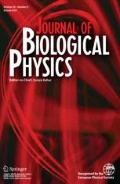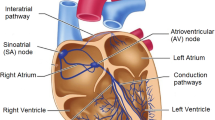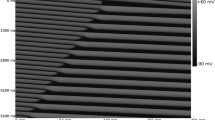Abstract
Various forms of heart disease are associated with remodeling of the heart muscle, which results in a perturbation of cell-to-cell electrical coupling. These perturbations may alter the trajectory of spiral wave drift in the heart muscle. We investigate the effect of spatially extended inhomogeneity of transverse cell coupling on the spiral wave trajectory using a simple active media model. The spiral wave was either attracted or repelled from the center of inhomogeneity as a function of cell excitability and gradient of the cell coupling. High levels of excitability resulted in an attraction of the wave to the center of inhomogeneity, whereas low levels resulted in an escape and termination of the spiral wave. The spiral wave drift velocity was related to the gradient of the coupling and the initial position of the wave. In a diseased heart, a region of altered transverse coupling corresponds with local gap junction remodeling that may be responsible for stabilization-destabilization of spiral waves and hence reflect potentially important targets in the treatment of heart arrhythmias.








Similar content being viewed by others
References
Zipes, D.P., Jalife, J.: Cardiac Electrophysiology: From Cell to Bedside, 4th edn. Saunders, Philadelphia (2004)
Fenton, F., Karma, A.: Vortex dynamics in three-dimensional continuous myocardium with fiber rotation: filament instability and fibrillation (vol. 8, p. 20, 1998). Chaos 8, 879–879 (1998)
Saffitz, J.E., Kanter, H.L., Green, K.G., Tolley, T.K., Beyer, E.C.: Tissue-specific determinants of anisotropic conduction velocity in canine atrial and ventricular myocardium. Circ. Res. 74, 1065–1070 (1994)
de Bakker, J.M., van Capelle, F.J., Janse, M.J., Tasseron, S., Vermeulen, J.T., de Jonge, N., Lahpor, J.R.: Slow conduction in the infarcted human heart. ‘Zigzag’ course of activation. Circulation 88, 915–926 (1993)
Polontchouk, L., Haefliger, J.A., Ebelt, B., Schaefer, T., Stuhlmann, D., Mehlhorn, U., Kuhn-Regnier, F., De Vivie, E.R., Dhein, S.: Effects of chronic atrial fibrillation on gap junction distribution in human and rat atria. J. Am. Coll. Cardiol. 38, 883–891 (2001)
Saffitz, J.E., Corr, P.B., Sobel, B.E.: Arrhythmogenesis and ventricular dysfunction after myocardial infarction: is anomalous cellular coupling the elusive link? Circulation 87, 1742–1745 (1993)
Paoletti, M.S., Solomon, T.H.: Front propagation and mode-locking in an advection-reaction-diffusion system. Phys. Rev. E 72(4), (2005). doi:10.1103/PhysRevE.72.046204
Winfree, A.T.: Varieties of spiral wave behavior: an experimentalist’s approach to the theory of excitable media. Chaos 1, 303–334 (1991)
Zemlin, C., Mironov, S., Pertsov, A.: Delayed success in termination of three-dimensional reentry: role of surface polarization. J. Cardiovasc. Electrophysiol. 14, S257–S263 (2003)
Kuklik, P., Wong, C.X., Brooks, A.G., Zebrowski, J.J., Sanders, P.: Role of spiral wave pinning in inhomogeneous active media in the termination of atrial fibrillation by electrical cardioversion. Comput. Biol. Med. 40, 363–372 (2010)
Pumir, A., Krinsky, V.I.: How does an electric field defibrillate cardiac muscle? Physica D 91, 205–219 (1996)
Lammers, W.J.E.P., Kirchhof, C., Bonke, F.I.M., Allessie, M.A.: Vulnerability of rabbit atrium to reentry by hypoxia - role of inhomogeneity in conduction and wavelength. Am. J. Physiol. 262, H47–H55 (1992)
Kuklik, P., Zebrowski, J.J.: Reentry wave formation in excitable media with stochastically generated inhomogeneities. Chaos 15, 33301 (2005)
Bub, G., Shrier, A., Glass, L.: Spiral wave generation in heterogeneous excitable media. Phys. Rev. Lett. 88, 058101 (2002)
Li, B.W., Zhang, H., Ying, H.P., Hu, G.: Coherent wave patterns sustained by a localized inhomogeneity in an excitable medium. Phys. Rev. E 79, 026220 (2009)
Xu, A., Guevara, M.R.: Two forms of spiral-wave reentry in an ionic model of ischemic ventricular myocardium. Chaos 8, 157–174 (1998)
Kuklik, P., Szumowski, L., Sanders, P., Zebrowsi, J.J.: Spiral wave breakup in excitable media with an inhomogeneity of conduction anisotropy. Comput. Biol. Med. 40, 775–780 (2010)
Xie, F., Weiss, J.N.: Interaction and breakup of inwardly rotating spiral waves in an inhomogeneous oscillatory medium. Phys. Rev. E 75, 016107 (2007)
Shajahan, T.K., Sinha, S., Pandit, R.: Spiral-wave dynamics depend sensitively on inhomogeneities in mathematical models of ventricular tissue. Phys. Rev. E 75, 011929 (2007)
Hendrey, M., Ott, E., Antonsen, Jr., T.M.: Spiral wave dynamics in oscillatory inhomogeneous media. Phys. Rev. E 61, 4943–4953 (2000)
Mikhailov, A.S., Davydov, V.A., Zykov, V.S.: Complex dynamics of spiral waves and motion of curves. Physica D 70, 1–39 (1994)
Jugdutt, B.I.: Remodeling of the myocardium and potential targets in the collagen degradation and synthesis pathways. Curr. Drug Targets Cardiovasc. Haematol. Disord. 3, 1–30 (2003)
Davidenko, J.M., Pertsov, A.V., Salomonsz, R., Baxter, W., Jalife, J.: Stationary and drifting spiral waves of excitation in isolated cardiac muscle. Nature 355, 349–351 (1992)
Rogers, J.M., McCulloch, A.D.: Nonuniform muscle fiber orientation causes spiral wave drift in a finite element model of cardiac action potential propagation. J. Cardiovasc. Electrophysiol. 5, 496–509 (1994)
Lim, Z.Y., Maskara, B., Aguel, F., Emokpae, R., Tung, L.: Spiral wave attachment to millimeter-sized obstacles. Circulation 114, 2113–2121 (2006)
Cabo, C., Boyden, P.A.: Heterogeneous gap junction remodeling stabilizes reentrant circuits in the epicardial border zone of the healing canine infarct: a computational study. Am. J. Physiol. 291, H2606–H2616 (2006)
Panfilov, A.V., Keener, J.P.: Reentry in 3-dimensional Fitzhugh-Nagumo medium with rotational anisotropy. Physica D 84, 545–552 (1995)
Qu, Z.L., Kil, K., Xie, F.G., Garfinkel, A., Weiss, J.N.: Scroll wave dynamics in a three-dimensional cardiac tissue model: roles of restitution, thickness, and fiber rotation. Biophys. J. 78, 2761–2775 (2000)
Majumder R., Nayak A.R., Pandit R.: Scroll-wave dynamics in human cardiac tissue: lessons from a mathematical model with inhomogeneities and fiber architecture. PLoS ONE 6(4), e18052 (2011). doi:10.1371/journal.pone.0018052
Fenton, F., Karma, A.: Fiber-rotation-induced vortex turbulence in thick myocardium. Phys. Rev. Lett. 81, 481–484 (1998)
Davydov, V.A., Morozov, V.G., Davydov, N.V., Yamaguchi, T.: Propagation of autowaves in excitable media with chiral anisotropy. Phys. Lett. A 325, 334–339 (2004)
Beaudoin, D.L., Roth, B.J.: The effect of the fiber curvature gradient on break excitation in cardiac tissue. Pace 29, 496–501 (2006)
Tseng, W.I., Reese, T.G., Weisskoff, R.M., Wedeen, V.J.: Cardiac diffusion tensor MRI in vivo without strain correction. Magn. Reson. Med. 42, 393–403 (1999)
Ho, S.Y., Anderson, R.H., Sanchez-Quintana, D.: Atrial structure and fibres: morphologic bases of atrial conduction. Cardiovasc. Res. 54, 325–336 (2002)
Fitzhugh, R.: Impulses and physiological states in theoretical models of nerve membrane. Biophys. J. 1, 445–466 (1961)
Tobon, C., Ruiz, C., Saiz, J., Heidenreich, E., Hornero, F.: Reentrant mechanisms triggered by ectopic activity in a three-dimensional realistic model of human atrium. A computer simulation study. Comput. Cardiol. 1–2, 629–632, 1112 (2008)
Seemann, G., Höper, C., Sachse, F.B., Dossel, O., Holden, A.V., Zhang, H.G.: Heterogeneous three-dimensional anatomical and electrophysiological model of human atria. Philos. Trans. R. Soc. A 364, 1465–1481 (2006)
Roberts, D.E., Hersh, L.T., Scher, A.M.: Influence of cardiac fiber orientation on wavefront voltage, conduction velocity, and tissue resistivity in the dog. Circ. Res. 44, 701–712 (1979)
Ten Tusscher, K.H., Panfilov, A.V.: Reentry in heterogeneous cardiac tissue described by the Luo-Rudy ventricular action potential model. Am. J. Physiol. 284, H542–H548 (2003)
Krinsky, V.V., Hamm, E., Voignier, V.V.: Dense and sparse vortices in excitable media drift in opposite directions in electric field. Phys. Rev. Lett. 76, 3854–3857 (1996)
Pazo, D., Kramer, L., Pumir, A., Kanani, S., Efimov, I., Krinsky, V.: Pinning force in active media. Phys. Rev. Lett. 93(16), (2004). doi:10.1103/PhysRevLett.93.168303
Lin, J.W., Garber, L., Qi, Y.R., Chang, M.G., Cysyk, J., Tung, L.: Region of slowed conduction acts as core for spiral wave reentry in cardiac cell monolayers. Am. J. Physiol. 294, H58–H65 (2008)
Tanaka, M., Isomura, A., Horning, M., Kitahata, H., Agladze, K., Yoshikawa, K.: Unpinning of a spiral wave anchored around a circular obstacle by an external wave train: common aspects of a chemical reaction and cardiomyocyte tissue. Chaos 19, 043114 (2009)
Agladze, K., Kay, M.W., Krinsky, V., Sarvazyan, N.: Interaction between spiral and paced waves in cardiac tissue. Am. J. Physiol. 293, H503–H513 (2007)
Bittihn, P., Squires, A., Luther, G., Bodenschatz, E., Krinsky, V., Parlitz, U., Luther, S.: Phase-resolved analysis of the susceptibility of pinned spiral waves to far-field pacing in a two-dimensional model of excitable media. Philos. Trans. A Math. Phys. Eng. Sci. 368, 2221–2236 (2010)
Bian, W.N., Bursac, N.: Engineered skeletal muscle tissue networks with controllable architecture. Biomaterials 30, 1401–1412 (2009)
Author information
Authors and Affiliations
Corresponding author
Rights and permissions
About this article
Cite this article
Kuklik, P., Sanders, P., Szumowski, L. et al. Attraction and repulsion of spiral waves by inhomogeneity of conduction anisotropy—a model of spiral wave interaction with electrical remodeling of heart tissue. J Biol Phys 39, 67–80 (2013). https://doi.org/10.1007/s10867-012-9286-4
Received:
Accepted:
Published:
Issue Date:
DOI: https://doi.org/10.1007/s10867-012-9286-4




